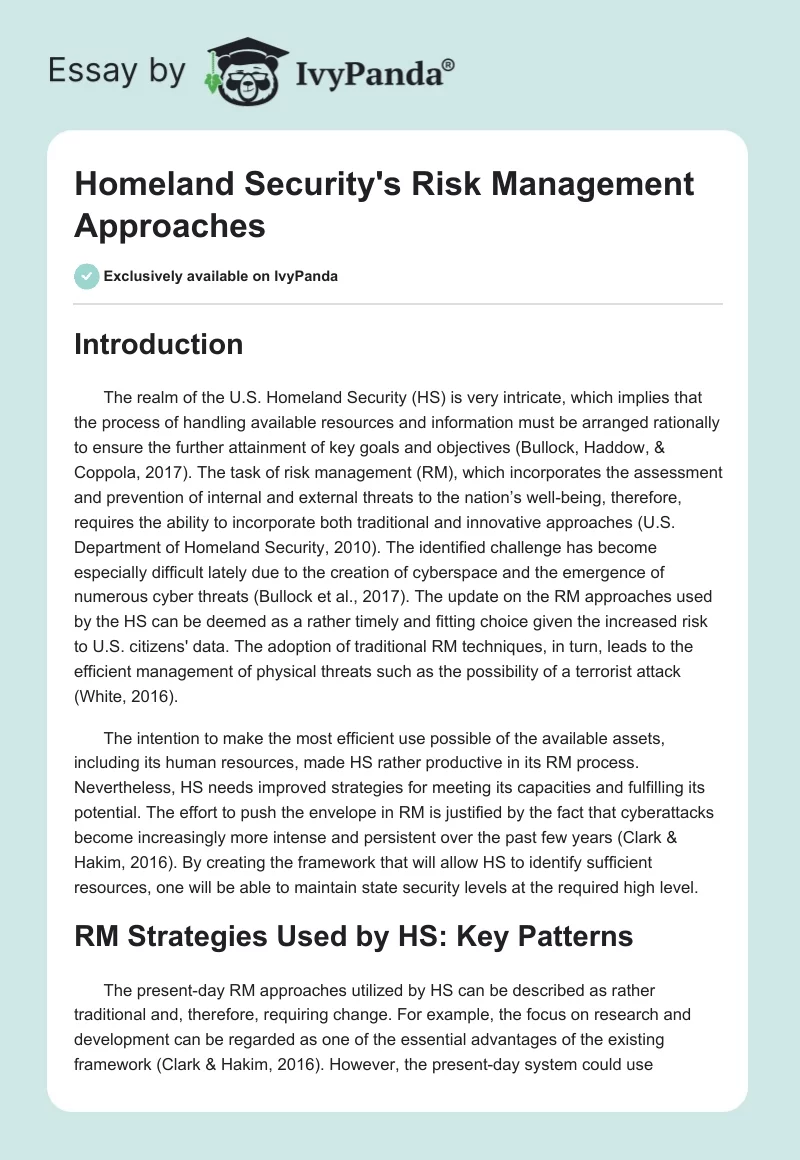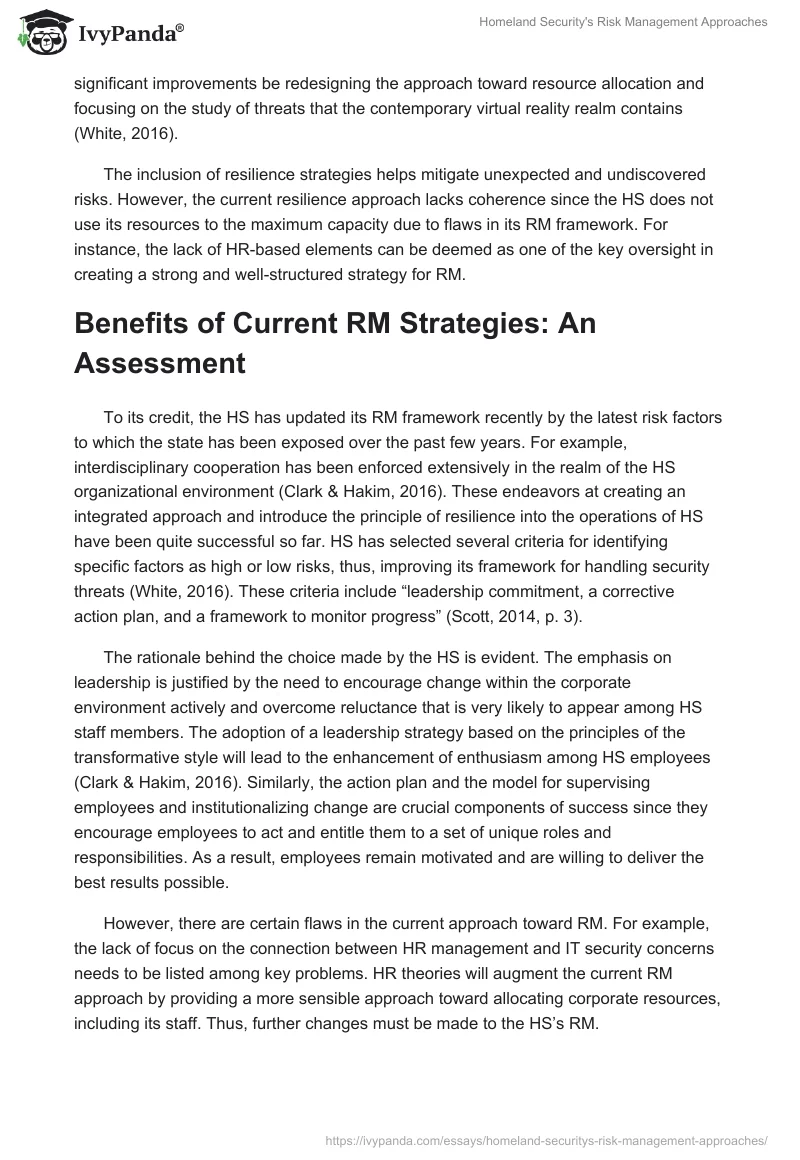Introduction
The realm of the U.S. Homeland Security (HS) is very intricate, which implies that the process of handling available resources and information must be arranged rationally to ensure the further attainment of key goals and objectives (Bullock, Haddow, & Coppola, 2017). The task of risk management (RM), which incorporates the assessment and prevention of internal and external threats to the nation’s well-being, therefore, requires the ability to incorporate both traditional and innovative approaches (U.S. Department of Homeland Security, 2010). The identified challenge has become especially difficult lately due to the creation of cyberspace and the emergence of numerous cyber threats (Bullock et al., 2017). The update on the RM approaches used by the HS can be deemed as a rather timely and fitting choice given the increased risk to U.S. citizens’ data. The adoption of traditional RM techniques, in turn, leads to the efficient management of physical threats such as the possibility of a terrorist attack (White, 2016).
The intention to make the most efficient use possible of the available assets, including its human resources, made HS rather productive in its RM process. Nevertheless, HS needs improved strategies for meeting its capacities and fulfilling its potential. The effort to push the envelope in RM is justified by the fact that cyberattacks become increasingly more intense and persistent over the past few years (Clark & Hakim, 2016). By creating the framework that will allow HS to identify sufficient resources, one will be able to maintain state security levels at the required high level.
RM Strategies Used by HS: Key Patterns
The present-day RM approaches utilized by HS can be described as rather traditional and, therefore, requiring change. For example, the focus on research and development can be regarded as one of the essential advantages of the existing framework (Clark & Hakim, 2016). However, the present-day system could use significant improvements be redesigning the approach toward resource allocation and focusing on the study of threats that the contemporary virtual reality realm contains (White, 2016).
The inclusion of resilience strategies helps mitigate unexpected and undiscovered risks. However, the current resilience approach lacks coherence since the HS does not use its resources to the maximum capacity due to flaws in its RM framework. For instance, the lack of HR-based elements can be deemed as one of the key oversight in creating a strong and well-structured strategy for RM.
Benefits of Current RM Strategies: An Assessment
To its credit, the HS has updated its RM framework recently by the latest risk factors to which the state has been exposed over the past few years. For example, interdisciplinary cooperation has been enforced extensively in the realm of the HS organizational environment (Clark & Hakim, 2016). These endeavors at creating an integrated approach and introduce the principle of resilience into the operations of HS have been quite successful so far. HS has selected several criteria for identifying specific factors as high or low risks, thus, improving its framework for handling security threats (White, 2016). These criteria include “leadership commitment, a corrective action plan, and a framework to monitor progress” (Scott, 2014, p. 3).
The rationale behind the choice made by the HS is evident. The emphasis on leadership is justified by the need to encourage change within the corporate environment actively and overcome reluctance that is very likely to appear among HS staff members. The adoption of a leadership strategy based on the principles of the transformative style will lead to the enhancement of enthusiasm among HS employees (Clark & Hakim, 2016). Similarly, the action plan and the model for supervising employees and institutionalizing change are crucial components of success since they encourage employees to act and entitle them to a set of unique roles and responsibilities. As a result, employees remain motivated and are willing to deliver the best results possible.
However, there are certain flaws in the current approach toward RM. For example, the lack of focus on the connection between HR management and IT security concerns needs to be listed among key problems. HR theories will augment the current RM approach by providing a more sensible approach toward allocating corporate resources, including its staff. Thus, further changes must be made to the HS’s RM.
Possible Improvements: Enhancing Security
Apart from incorporating HR principles into the existing RM approach, one should also develop the tools that will help monitor and control changes in the HS RM process. The use of grant funding should also be explored as a possible initiative for reinforcing the security levels within the HS context. For instance, grants for research in the domain of cybersecurity and the means of reducing exposure to risks by establishing tighter control over the data that is transferred via social networks. Also, creating educational programs that will instruct people in the realm of social networks and blogospheres about maintaining security levels high and reducing the threat of personal data exposure must be regarded as a priority. While a range of present-day HS grants is focused on creating software that will contribute to a rapid boost in cybersecurity levels, the human factor is rarely considered and studied (Bullock et al., 2017). The identified gap must be filled by creating grant options and opportunities for in-depth research.
Conclusion: Importance of RM for HS in the Cyber environment
Because of the lack of success in creating an efficient resource management strategy, HS becomes vulnerable to external threats, particularly, in the cyberenvironment. To its credit, the HS realizes the importance of keeping up the pace with the technological development and, thus, advances its strategies to handle the threat of cyberattacks. However, its current approach toward resources management could use a massive improvement. A reconsideration of how roles and responsibilities are assigned to staff members will entail a change in the speed and efficacy of data management processes. Consequently, gradual improvement can be expected.
The current capacity shortfalls observed in the HS environment are also linked to its IT strategy, which means that the approach toward data management will have to be connected to the HRM strategies utilized in its organizational environment. Therefore, there is an urgent need to integrate HRM concepts into the current RM strategy. The resulting rearrangement of roles and responsibilities will contribute to a more rational usage of corporate resources and, thus, more timely responses to internal and external threats.
The use of the capabilities-based planning approach should be deemed as an important addition to the current framework for RM in the context of the HS. Helping HS to focus on the issues associated with human resources, the identified strategy is bound to help HS develop a coherent device for retaining its cybersecurity levels high. As a result, the personal data of U.S. residents will be kept intact.
References
Bullock, J. A., Haddow, G. E., & Coppola, G. P. (2017). Homeland security: The essentials (2nd ed.). Cambridge, MA: Butterworth-Heinemann.
Clark, R. M., & Hakim, S. (2016). Cyber-physical security: Protecting critical infrastructure at the state and local level. New York, NY: Springer.
Scott, G. A. (2014). Roundtable on reauthorizing the Department of Homeland Security. Washington, DC: U.S. Government Accountability Office.
U.S. Department of Homeland Security. (2010). Quadrennial homeland security review report: A strategic framework for a secure homeland. Washington, DC: Government Printing Office.
White, J. R. (2016). Terrorism and homeland security. Boston, MA: Cengage Learning.


